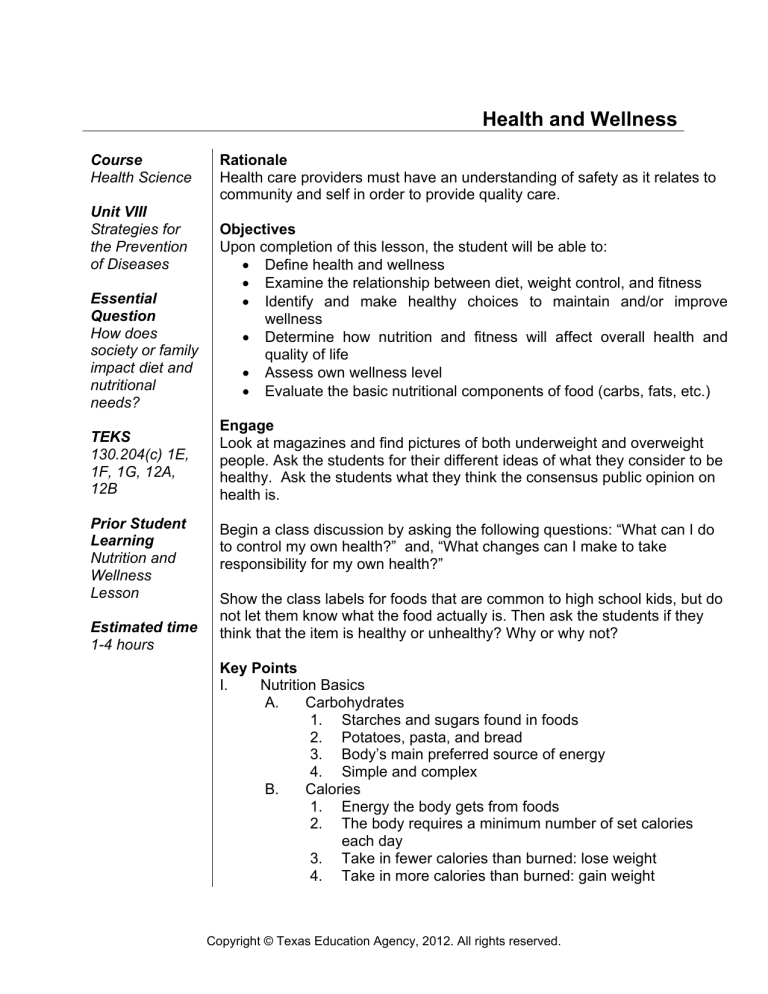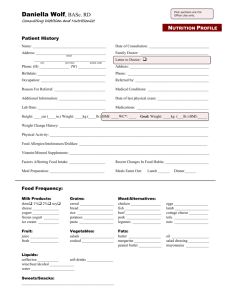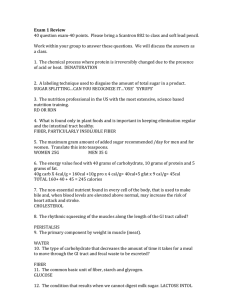Health and Wellness

Health and Wellness
Course
Health Science
Unit VIII
Strategies for the Prevention of Diseases
Essential
Question
How does society or family impact diet and nutritional needs?
TEKS
130.204(c) 1E,
1F, 1G, 12A,
12B
Prior Student
Learning
Nutrition and
Wellness
Lesson
Estimated time
1-4 hours
Rationale
Health care providers must have an understanding of safety as it relates to community and self in order to provide quality care.
Objectives
Upon completion of this lesson, the student will be able to:
Define health and wellness
Examine the relationship between diet, weight control, and fitness
Identify and make healthy choices to maintain and/or improve wellness
Determine how nutrition and fitness will affect overall health and quality of life
Assess own wellness level
Evaluate the basic nutritional components of food (carbs, fats, etc.)
Engage
Look at magazines and find pictures of both underweight and overweight people. Ask the students for their different ideas of what they consider to be healthy. Ask the students what they think the consensus public opinion on health is.
Begin a class discussion by asking the following questions: “What can I do to control my own health?” and, “What changes can I make to take responsibility for my own health?”
Show the class labels for foods that are common to high school kids, but do not let them know what the food actually is. Then ask the students if they think that the item is healthy or unhealthy? Why or why not?
Key Points
A. Carbohydrates
1. Starches and sugars found in foods
2. Potatoes, pasta, and bread
3. Body’s main preferred source of energy
4. Simple and complex
B. Calories
1. Energy the body gets from foods
2. The body requires a minimum number of set calories each day
3. Take in fewer calories than burned: lose weight
4. Take in more calories than burned: gain weight
Copyright © Texas Education Agency, 2012. All rights reserved.
C. Fiber
1. Found in the tough, stringy part of vegetables and fruits
2. A special form of complex carbohydrate
3. Although it cannot be digested, it is used as energy
4. Plays an important role in removing waste
D. Proteins
1. Helps build strong and healthy bones, muscles, tissue, and teeth
2. Helps make new blood cells, and protect important organs, such as heart, brain, lungs, and skin
E. Fats
1. Most concentrated form of energy; very thick substances; do not dissolve in water
2. Fats in beef, pork, egg yolks, and dairy foods higher in saturated fat than in fish or chicken
3. Unsaturated fat is liquid fat, proven to reduce heart disease
F. Cholesterol is a fat-like substance produced in the liver of all animals, and found only in animals.
G. Vitamins
1. Compounds that help regulate digestion, and metabolism
2. Needed in small amounts, so they are called micronutrients
3. Have no calories, but some do give you energy
H. Minerals
1. Inorganic substances that the body cannot manufacture
2. Act like workers regulating many important body functions
3. One important mineral in the body is calcium which helps develop strong bones, and build strong teeth.
III. The World Health Organization defines health as, “Health is a state of complete physical, mental, and social well-being and not merely the absence of disease or infirmity.”
A. This definition of health has been expanded with emphasis on holistic health.
B. We think in terms of the body working as a unit (mental, physical, social, and emotional) in order to maintain and promote optimum wellness through our daily actions.
C. Wellness implies feeling good, regardless of infirmity or disease.
D. Holistic refers to the wellbeing of the whole person. It is important to meet all of these needs when giving care to the patient/client.
IV. Wellness and/or preventive health care emphasize keeping patients well and not waiting until they are ill to provide treatment. Health education is vital to maintaining good health.
Copyright © Texas Education Agency, 2012. All rights reserved.
A. The holistic wellness approach includes: a. achieved through routine physicals, rest, good nutrition, weight control, elimination of waste, aerobic exercise, immunizations, well-baby check ups b. avoid drugs, alcohol, tobacco, and excessive food intake
2. Mental fitness: allows individual to interact effectively with others and feel balanced a. characteristics of mentally healthy person
1. self-directed
2. has a sense of belonging
3. trusts own senses and feelings
6. practices stress management
3. Social Well-Being: allows individual to feel comfortable with others and allows the acceptance of behavior, attitudes, and beliefs; includes enjoying companionship, sharing ideas and thoughts, having a sense of belonging and showing enthusiasm
V. The Health Care System is a network of services available to people seeking treatment for health problems or assistance with maintaining and promoting health.
A. The services are primary, secondary, tertiary, and extended care
1. Primary Care—health services provided by the first health care professional or agency. Ex. Family practice doctor in an office or clinic
2. Secondary Care—health services to which primary caregivers refer patients for consultation and additional testing
3. Tertiary Care—takes place in the hospital where complex technology and specialists are available who no longer require hospitalization but continue to require health services. Ex. Nursing homes, home health agency
VI. National Health Goals – a national effort, with specific goals and strategies for improving the nation’s health by preventing chronic illnesses, injuries and infectious diseases. Utilizes the combined expertise of individuals from public health services, state health departments, national health organizations, and members of the
Institute of Medicine of the National Academy of Sciences.
A. Goals
Copyright © Texas Education Agency, 2012. All rights reserved.
1. Increase the span of health life for Americans
2. Reduce disparities among Americans
3. Achieve access to preventive services for all Americans
VII. Agencies involved in health and wellness in the community controlling infection include
A. Center for Disease Control and Prevention (CDC)
B. Infection control departments of hospitals and other agencies
C. City/county/public health departments
A. Public Health Department (PHD)
IX. Schedules for recommended physicals, procedures, screening, and tests
A. Advice from physicians, American Cancer Society, American
X. Heart Association, etc.
XI. Recommended breast and testicular screenings/PSA schedules
Activity
I. Record every food item consumed for 7 days with calories, fat, protein, carbs, etc.
II. Complete Fast Food vs. Home Food Activity
III. Bring in food items already consumed from home (empty boxes and bottles) – groups go grocery shopping in the classroom and make a breakfast, lunch, and dinner. Determine nutritional value of meals.
IV. Self-evaluation: Complete the Health and Fitness Assessment.
Find height, weight, BMI, body fat using hand-held devices or calipers.
Take the average of the class for each item and see what the overall health status is of the class.
Assessment
Successful record of food diary
Successful completion of Health and Fitness Assessment
Successful completion of Fast Food vs. Home Food Activity
Materials
Bioelectrical Impedance Device
Body Fat Calipers
Scale
BMI Calculators/Charts
Fast food nutrition facts brochure - most fast food chains have a brochure/pamphlet to take (or online) that lists all their items. Get a class set for your classroom or use the internet to access the nutrition facts. http://www.health.gov/dietaryguidelines/dga2005/healthieryou/contents.htm
Copyright © Texas Education Agency, 2012. All rights reserved.
http://www.nhlbisupport.com/bmi/bmicalc.htm
- Calculate your body mass index. http://www.caloriecontrol.org/ - Contains the Calorie Counter Calculator to enable meal planning and diet management and the Enhanced Calorie
Calculator to keep track of all your meals. http://www.nal.usda.gov/fnic/Fpyr/pyramid.html
- The food guide pyramid http://netx.squaremeals.org/organize_lesson_plan.aspx?EntryNo=151
Fast food websites
Daily nutrition calculator
Accommodations for Learning Differences
For reinforcement, students will demonstrate a proper pre-exercise stretching routine used in sports medicine. (sports medicine competitive event)
For enrichment, students will develop pamphlets for several age groups to encourage health and wellness strategies.
For enrichment, students will watch TV for a pre-selected amount of time
(prime-time/Saturday morning/late night) on a major TV channel and report the occurrences of food commercials vs. all of the others. Students should report what kind of food or drink was advertised, who they think the commercial was targeted to, and how advertising can influence their buying habits and lifestyle.
National and State Education Standards
National Health Science Cluster Standards
HLC06.02 Safety, Health, and Environmental
Health care workers will understand the fundamentals of wellness and the prevention of disease processes. They will practice preventive health behaviors among the clients.
TEKS
130.204(c) (1)E summarize biological and chemical processes that maintain homeostasis;
130.204(c) (1)F explain the changes in structure and function due to trauma and disease;
130.204(c) (1)G research the global impact of disease prevention and cost containment;
130.204(c) (12)A research wellness strategies for the prevention of disease; and
Copyright © Texas Education Agency, 2012. All rights reserved.
130.204(c) (12)B evaluate positive and negative effects of relationships on physical and emotional health such as peers, family, and friends.
Texas College and Career Readiness Standards
English Language Arts
II. B. Understand new vocabulary and concepts and use them accurately in reading writing and speaking.
III. B. Develop effective speaking styles for both group and one-on-one situations.
IV. A. Apply listening skills as an individual and as a member of a group in a variety of settings.
IV. B. 2. Listen actively and effectively in one-on-one communication situations.
Mathematics
I. B. 1. Perform computations with real and complex numbers.
IV. A. 1. Select and use the appropriate type of unit for the attribute being measured.
IV. B. 1. Convert from 1 measuring system to another.
Science
II. A. 1. Understand the real number system and its properties.
II. A. 7. Use calculators, spreadsheets, computers, etc., in data analysis.
Copyright © Texas Education Agency, 2012. All rights reserved.
Name:
Date:
Period:
Health and Fitness Assessment
1.
Calculate your height in inches using the scale __________________________________
2.
Calculate your weight in pounds using the scale _________________________________
3.
Calculate your Body Mass Index (BMI) using the BMI dial ________________________
My BMI indicates that I am: (Please circle)
Underweight <18.5
Normal
Overweight
Obese, Class
18.5 – 24.9
25.0 – 29.9
I
II
30.0 – 34.9
35.0 – 39.9
III >40
4.
A healthy weight range for my height (based on the BMI chart) is:
_________________________
5.
Calculate your Body Fat % using the Bioelectrical Impedance devise
_______________________
Percentile
Body Fat Composition for Men
20-29
AGE
30-39 40-49 50-59 60+
Percentile
Body Fat Composition for Women
AGE
20-29 30-39 40-49 50-59 60+
90
30 th
percentile = well above average; 70 th
percentile = above average; 50 th
percentile = average; th
percentile = below average; 10 th
percentile = well below average
Copyright © Texas Education Agency, 2012. All rights reserved.
6.
What percentile do you fit in? ____________________
7.
Calculate your blood pressure using the electric monitor:____________________________
High > 140/90
Low <100/70
8.
Calculate your heart rate using the electric monitor: ________________________________
High
Normal
Low
>100
60-90
<100
9.
My physical activity level is: (Please circle)
SEDENTARY MODERATE ACTIVE
Sedentary : means a lifestyle that includes only the light physical activity associated with typical day-to-day life.
Moderate : means a lifestyle that includes physical activity equivalent to walking about 1.5 to 3 miles per day at 3 to 4 miles per hour, in addition to the light physical activity associated with typical day-to-day life.
Active : means a lifestyle that includes physical activity equivalent to walking more than 3 miles per day at 3 to 4 miles per hour, in addition to the light physical activity associated with typical day-to-day life.
10.
How did finding out your overall fitness and health level make you feel?
______________________________________________________________________________
______________________________________________________________________________
______________________________________________________________________________
______________________________________________________________________________
______________________________________________________________________________
______________________________________________________________________________
11.
What can you do to improve or maintain your status?
________________________________________________________________________
________________________________________________________________________
________________________________________________________________________
________________________________________________________________________
________________________________________________________________________
________________________________________________________________________
Copyright © Texas Education Agency, 2012. All rights reserved.
Fast Food VS. Home Food
Instructions: Using a fast food nutrition facts brochure choose one breakfast, lunch, and dinner meal and fill in the blanks with the proper nutrition facts per item.
To calculate your caloric needs, multiply your weight by 15; this is the amount of calories you need to maintain your weight.
To calculate fat calories, multiply the fat grams by 9.
To calculate the protein and carbohydrate calories, multiply the grams by 4.
CALORIC NEEDS: ___________________
Fast Food
Breakfast : Item _____________ Drink ____________ Hash _____________
Fat Cal.___________
Carbs (g) __________
Fat Cal.___________
Carbs (g) __________
Fat Cal.___________
Carbs (g) __________
Pro.Cal.___________ Pro.Cal.___________
Sodium (mg) _______ Sodium (mg) _______ Sodium (mg) _______
Lunch :
Fat (g) ____________
Fat Cal.___________
Carbs (g) __________
Fat (g) ____________ Fat (g) ___________
Fat Cal.___________ Fat Cal.___________
Carbs (g) __________ Carbs (g) __________
Pro.Cal.___________ Pro.Cal.___________
Sodium (mg) _______ Sodium (mg) _______ Sodium (mg) _______
Dinner :
Fat (g) ____________
Fat Cal.___________
Carbs (g) __________
Fat (g) ____________ Fat (g)____________
Fat Cal.____________ Fat Cal. ___________
Carbs (g) __________ Carbs (g) __________
Pro.Cal.___________ Pro.Cal.___________
Sodium (mg) _______ Sodium (mg) _______ Sodium (mg) _______
Calculate your total calories and milligrams of sodium for the day by adding up all 9 items. Using your caloric needs that you calculated at the top of this worksheet, divide the total calories -- fat calories, carbohydrate calories, and protein calories -- by your total caloric needs. Then multiply this number by 100 to get your percent daily value. As a good rule of thumb you should consume roughly 60% carbohydrates, no more than 30% fat, and about 10% protein. To calculate the percent daily value of sodium, divide your total by 2400, and then multiply by 100. Let’s see what you would accomplish by eating three meals at McDonald’s.
Totals for the Day: % Daily Value
_______________
Copyright © Texas Education Agency, 2012. All rights reserved.



